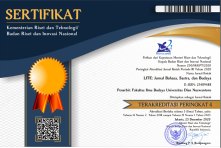Swear Words Types Utilization in Traumazine Album Song Lyrics by Megan Thee Stallion
Abstract
Keywords
References
Adams. (2016). In Praise of Profanity. Oxford University Press.
Allington, D. (2020). Antisemitism in the Urban Dictionary and the Responsibilities of Online Publishers. Journal of Contemporary Antisemitism, 3(1), 1–10. https://doi.org/10.26613/jca/3.1.40
Arafah, B., & Hasyim, M. (2019). Linguistic functions of emoji in social media communication. SSRN, 35(24). https://ssrn.com/abstract=3609199
Baker, F., & Bor, W. (2008). Can music preference indicate mental health status in young people? Australasian Psychiatry, 16(4), 284–288. https://doi.org/10.1080/10398560701879589
Barry. (2017). Beginning Theory an Introduction to Literary and Cultural Theory (4th edition). Manchester University Press.
Battistella, E. L. (2005). Bad Language: Are Some Words Better than Others?
Cachola, I., Holgate, E., Preot, D., & Jessy Li, J. (2018). Expressively vulgar: The socio-dynamics of vulgarity and its effects on sentiment analysis in social media. 2927–2938. https://github.com/ericholgate/vulgartwitter.
Chirico. (2014). Damn!: A Cultural History of Swearing in Modern America. Pitchstone Publishing.
Condit-Schultz, N. (2017). MCFlow: A Digital Corpus of Rap Transcriptions. www.rapscience.net.
Creswell. (2014). Research Design Qualitative, Quantitative, and Mixed Methods Approaches (4th edition). SAGE Publications.
Creswell & Clark. (2017). Designing and Conducting Mixed Methods Research.
CRYSTAL DAVID. (2019). The Cambridge Encyclopedia of the English Language (3rd edition). Cambridge University Press.
Culler. (2015). Theory of the Lyrics. Hardvard University Press.
Ernes, J., & Wiwoho, G. (2020). AN ANALYSIS OF TABOO WORDS USED IN EXTENDED PLAYER ALBUM MORE MALICE BY SNOOP DOGG. LINGUAMEDIA Journal, 3(1).
Fandi, J., & Mardijono, J. J. (2022). Swear Words Used by The Mobile Legends Game Players. K@ta Kita, 10(3), 539–549. https://doi.org/10.9744/katakita.10.3.539-549
GHILAN. (2018). ADJUSTMENT COMPUTATIONS (6th edition). John Wiley & Sons.
Kroeger, P. (2018). Analyzing meaning : an introduction to semantics and pragmatics. Language Science Press.
Lenci, A. (2018). Distributional Models of Word Meaning. Annu. Rev. Linguist, 4, 151–171. https://doi.org/10.1146/annurev-linguistics
Lobner. (2013). Understanding Semantics (2nd edition). Routledge. www.routledge.com/linguistics
Loh-haga, V. (2017). Gods & Goddesses of The Ancient World (45th Parallel Press). Cherry Lake Publishing.
Nassaji, H. (2015). Qualitative and descriptive research: Data type versus data analysis. In Language Teaching Research (Vol. 19, Issue 2, pp. 129–132). SAGE Publications Ltd. https://doi.org/10.1177/1362168815572747
Pandiangan, B. S., Tinggi, S., Asing, B., & Thuy, T. T. (n.d.). AN ANALYSIS OF DERIVATIONAL AND INFLECTIONAL MORPHEMES IN OLIVIA RODRIGO’S ALBUM “SOUR” Andrias Yulianto. In International Journal of Literature and Language Studies (IJLLS) (Vol. 1, Issue 2).
Prawinanto, A., & Bram, B. (2020). LET: Linguistics, Literature and English Teaching Journal SWEARING AND ITS MOTIVES IN THE ANTOLOGI RASA NOVEL. In Adityo Prawinanto LET: Linguistics, Literature and Language Teaching Journal (Vol. 10, Issue 1). http://jurnal.uin-antasari.ac.id/index.php
Prayuda, P. E., Adi, P., & Juniarta, K. (2019). THE ANALYSIS OF SWEAR WORDS USED BY THE CHARACTERS IN MOONLIGHT. International Journal of Language and Literature.
Serrano & Torres. (2015). The Rap Year Book: The Most Important Rap Song From Every Year Since 1979, Discussed, Debated, and Deconstructed. Harry N. Abrams. http://library.lol/main/B26655083CD17FA4060C982105C4E1E2
Simanjuntak, M. B. (2020). THE EDUCATIONAL VALUES OF THE MAIN CHARACTER IN BEAUTIFUL MIND FILM. JOURNAL OF ADVANCED ENGLISH STUDIES, 3(1), 1. https://doi.org/10.47354/jaes.v3i1.83
DOI: https://doi.org/10.33633/lite.v19i1.7820
Article Metrics
Abstract view : 281 timesPDF - 150 times Similarity Check - 63 times
Refbacks
- There are currently no refbacks.
Copyright (c) 2023 Bobby Samuel Pandiangan, Lerissa Daniela
ISSN Online: 2548-9588
This work is licensed under a Creative Commons Attribution-ShareAlike 4.0 International License.
This journal is published by Universitas Dian Nuswantoro, Semarang, Indonesia.
Indexing & Archiving:
IN COLLABORATION WITH:
Indonesian Pragmatics Association
Konsorsium Program Studi Jepang Indonesia
Center for Foreign Language Training
Asosiasi Studi Pendidikan Bahasa Jepang Indonesia







































